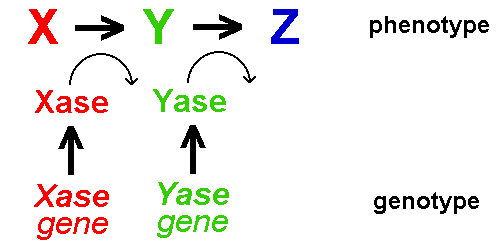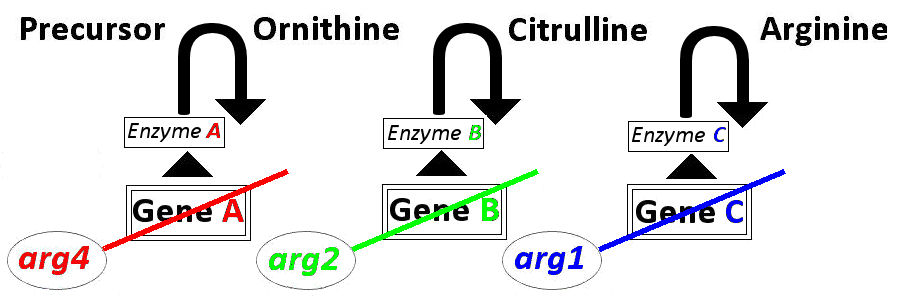
In Principle: Proteins are the products of genes.
Proteins catalyze biochemical reactions.
Such reactions produce phenotypes, either directly or indirectly.
Different alleles produce different phenotypes
Interaction between alleles in diploid organisms is the subject matter of Genetics
Beadle & Tatum experiment (1940s) on haploid Neurospora bread mold
haploid organisms have one allele at each gene locus
prototroph wild-type grows on simple medium
auxotroph mutants cannot grow on simple medium,
require supplementation with specific amino acids
[AKA autotrophs ("self feeder") and heterotrophs ("other feeder"), respectively] HOMEWORK
Hypothesis: "No-growth" phenotype results from a change in the genotype:
inability to synthesize amino acid is the result of loss of enzyme activity
each mutant corresponds to a defect in a particular enzyme:
"One gene, one enzyme" ()
[ Remember: Beadle & Tatum did not know about DNA in 1940 ]
Ex.: arg- mutants cannot grow without arginine, always grow with added arginine
particular mutant classes sometimes grow with other amino acids
(such as citrulline and/or ornithine)
|
Growth response to
added amino acids
|
| mutants |
none |
ornithine |
citrulline |
arginine |
| arg- 4 | - |
+ |
+ |
+ |
| arg- 2 | - |
- |
+ |
+ |
| arg- 1 | - |
- |
- |
+ |
=> These other
amino acids are involved in the arginine pathway:
Enzyme
defect
blocks
interconversion
of
precursors in the pathway.
Inference
of a haploid biosynthetic pathway

Each mutant class (arg4, arg2, & arg1)
affects a different enzyme in arginine biosynthesis
:
1. In the above discussion, I have used "mutant" but carefully avoided "mutation": WHY?
2. A common source of confusion for students is a seeming circularity, that since metabolites in this pathway are amino acids, and enzymes are made out of amino acids, therefore enzymes defects are equivalent to the absence of correspondong amino acids.
Bearing this in mind, critique the following statements:
"arg- mutants result in defective arginine."
"arg- mutants are defects of arginine."
"arg- mutants are due to absence of the gene for arginine."
"arg- mutants are enzymes that block synthesis of arginine."
[new] "arg4, arg2, and arg1 are different alleles of the arg gene."
3. Would you expect to observe an arg mutant class with the following phenotype? Explain why or why not
|
Growth response to
added amino acids
|
| mutant |
none |
ornithine |
citrulline |
arginine |
| arg-
X |
- |
+ |
- |
+ |
4. HOMEWORK: Consider the nature of mutant strains in the methionine metabolic pathway in Neurospora.
In a haploid organism, discovery of DNA shows the origin of metabolic "mutants":

mutate the DNA sequence of a gene
 modify / eliminate the
enzyme
modify / eliminate the
enzymeWhat about diploid organisms?
Diploid organisms have two alleles at each gene locus: one from each parent
Interactions between alleles at a locus are the subject matter of classical (Mendelian) genetics
"Online Mendelian Inheritance in Man" (OMIM) database
Examples from human biochemical genetics: "Inborn errors of metabolism"
First three involve disruptions of phenylalanine metabolism
Phenylketonuria (PKU) (Folling 1934) (OMIM citation 261600)
phenylalanine & byproducts accumulate in Central Nervous System
 mental
retardation
mental
retardation A defect of phenylalanine hydroxylase
phenyalanine metabolized to phenylpyruvic acid in alternative pathway
Detection & treatment
biochemical testing of newborns: Guthrie Test [Homework #18]
phenylalanine-restricted diet corrects inborn condition (Euphenics)
Maternal PKU occurs in children high fetal [phe] born to treated, asymptomatic mothers
[ Further information on PKU & related Inborn Errors of Metabolism ]
PKU arises from genetic variation at the Phenylalanine Hydroxylase (PAH) gene locus
Important: This gene is not a gene "for" PKU: it is a gene "for" PAH
Diploid humans each have two alleles at this locus
Allelic variants produce different levels of PAH activity
Consider diploid combinations of three (hypothetical) alleles: A, B, & C :
| Phenotypic consequences of
interactions between alleles at the PAH locus |
| Genotype |
PAH Activity |
[phe] uM |
PKU Phenotype |
| AA |
100% |
60 |
Standard (non-PKU) |
| AB |
30% |
120
|
Standard (non-PKU) |
| CC | 5% | 200 ~ 300 |
Hyperphenylalanemia:
no special diet required |
| BB |
0.3% |
600 ~ 2400 |
Classic PKU: special diet required |
[Alleles B & C) arise from DNA mutations in the PAH gene]
PKU is called a classic "recessive" genetic disease: What does this mean?
AB genotype shows same PKU phenotype as AA genotype: non-PKU
A allele shows haplosufficiency:
one "allele's worth" of product is sufficient for standard phenotype
or, expression of A allele "masks" expression of B allele
A is described as "dominant" to B in influencing PKU phenotype
B is described as "recessive" to A
and BB phenotype is different from AA / AB phenotype: PKU
but PAH activity phenotype of AB is intermediate between AA & BB
AB phenotype is closer to BB than AA (0% < 30% << 100%)
Is B therefore an "incomplete dominant" to A ?
and B produces a higher [phe] phenotype than A:
Is B therefore "dominant" to A ?
Distinguish molecular versus phenotypic expression (Homework #19)
| Homework #20 Predict the
PAH activity,
[phe], & PKU phenotypes of
the AC
and CB
genotypes.
Explain your
reasoning.Would you expect to find a dominant mutation in this pathway? Why or why not? What might be the nature of such a mutation? |
Other molecular disorders of Phenylalanine metabolism
Alkaptonuria (OMIM 203500): an illustration of "Classical" versus "Reverse" Genetics (Updated 08 Oct 2016)
an introduction to Ascertainment Bias
Oculo-cutaneous Albinism (OMIM 203100)
All text material © 2016 by Steven M. Carr
